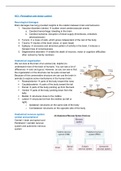College aantekeningen
Lecture 1: Perception and motor (3.6 Neuropsychology)
- Instelling
- Erasmus Universiteit Rotterdam (EUR)
This summary contains all the information from the first lecture of the course neuropsychology. It is supplemented with pictures from the slides and extensive notes from the professor.
[Meer zien]




